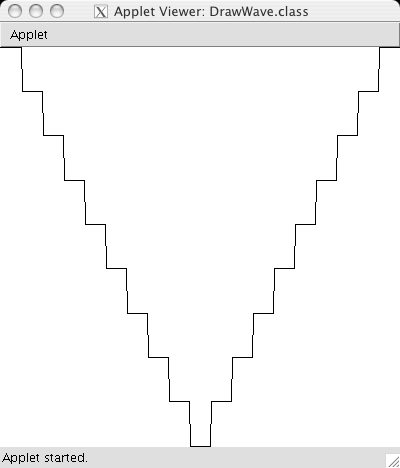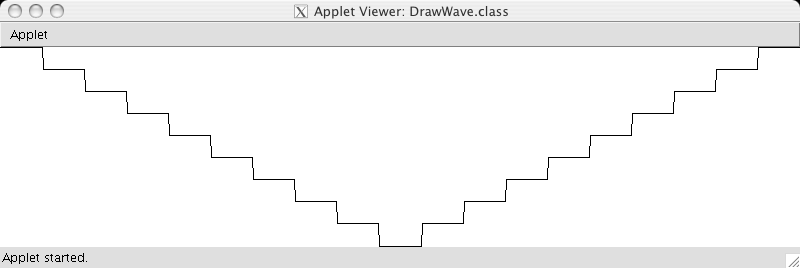- public Waveform () - This constructor will initialized fields you need in the class. For instance, you should set up an array to hold the digitally sampled wave, and a variable to keep track of how many samples are in the wave.
- public void read () - This method should read the digitally sampled wave from the standard input. That is, the user can type in the numbers and press 'ctrl-D' when finished, or you can run appletviewer with standard input redirected from a text file containing the sampled wave. Important: the Waveform class should be able to read in a digitized wave with any number of samples up to the capacity of machine. That is, there is no predetermined maximum number of samples.
- public int getSample (int i) - This method should get the ith sample in the wave. If i is less than 0, it should return the first sample. If i is beyond the number of samples in the wave, it should return the last sample. That way, any method that calls getSample doesn't have to worry whether it is out of bounds.
- public int getMiny () - This method should find and return value of the minimum sample.
- public int getMaxy () - This method should find and return the value of the maximum sample.
- public int getNsamples () - This method should return the number of samples.
- DrawWave(). This is the constructor. It should make an object of class Waveform and invoke the read method to read in a wave. The object should be a private field of the DrawWave class.
- paint (Graphics page). This is the method that overrides
JApplet's paint method and draws stuff on the graphics
window as in previous programs. This method should draw the waveform on the
window. The waveform should fit properly in the window so that the maximum
value is displayed at the bottom of the screen and the minimum value at the
top, with the first sample on the leftmost part of the screen and the last
sample on the rightmost part of the screen. When the screen is resized,
the waveform should be drawn properly again to fit within the new size. For example, when the
window is 400 × 400 and we use this simple input file, the
result should look like this>

When the window is resized to 800 × 200, the waveform should be stretched and squashed to look like this:

Testing Your Program
You can test your program on the following digitized wave files in addition to any you make up on your own: How do you get these files into your account? You can "save" them from your web browser, or try the wget command.Important Issues to Think About
- How big should I make the array?
Start out with, say, 10 elements and expand the array as needed. How do you do that? We go over that in class. Don't make the array huge to begin with; that is very inefficient, and there is always a bigger file that will break your program if you don't expand the array. Don't expand the array for every sample; in class we see how to expand the array very few times but continue to make efficient use of array storage. Make sure to keep a separate number indicating the number of samples versus the size of the array.
- How do I scale the waveform to fit in the window?
Let the number of samples be n, the maximum sample value be ymax, the minimum sample value be ymin, the width of the window in pixels be w, and the height of the window in pixels be h.
In the x-axis, the question is: which sample should be drawn at position x? The answer is given by x × n / (w-1). That is, we want to scale an index between 0 and n into x-positions between 0 and w-1.
In the y-axis, we need to scale values between ymin and ymax to values between 0 and h-1. I'll let you guys figure this one out on your own, but here's a hint: you'll want to subtract the minimum sample value from every sample so you can get values between 0 and something, and then use something similar to the scaling for x.
What To Turn In
Email your Waveform.java and DrawWave.java files as attachments in the same email message to our teaching assistant. Make sure you have put in comments such that a beginning Java programmer like you can understand the logic of your program.This program is due at 11:59pm, Monday, February 14, 2011. Late assignments will not be accepted. If you're not done with some part before it's due, turn in what you have for partial credit. Don't cheat.